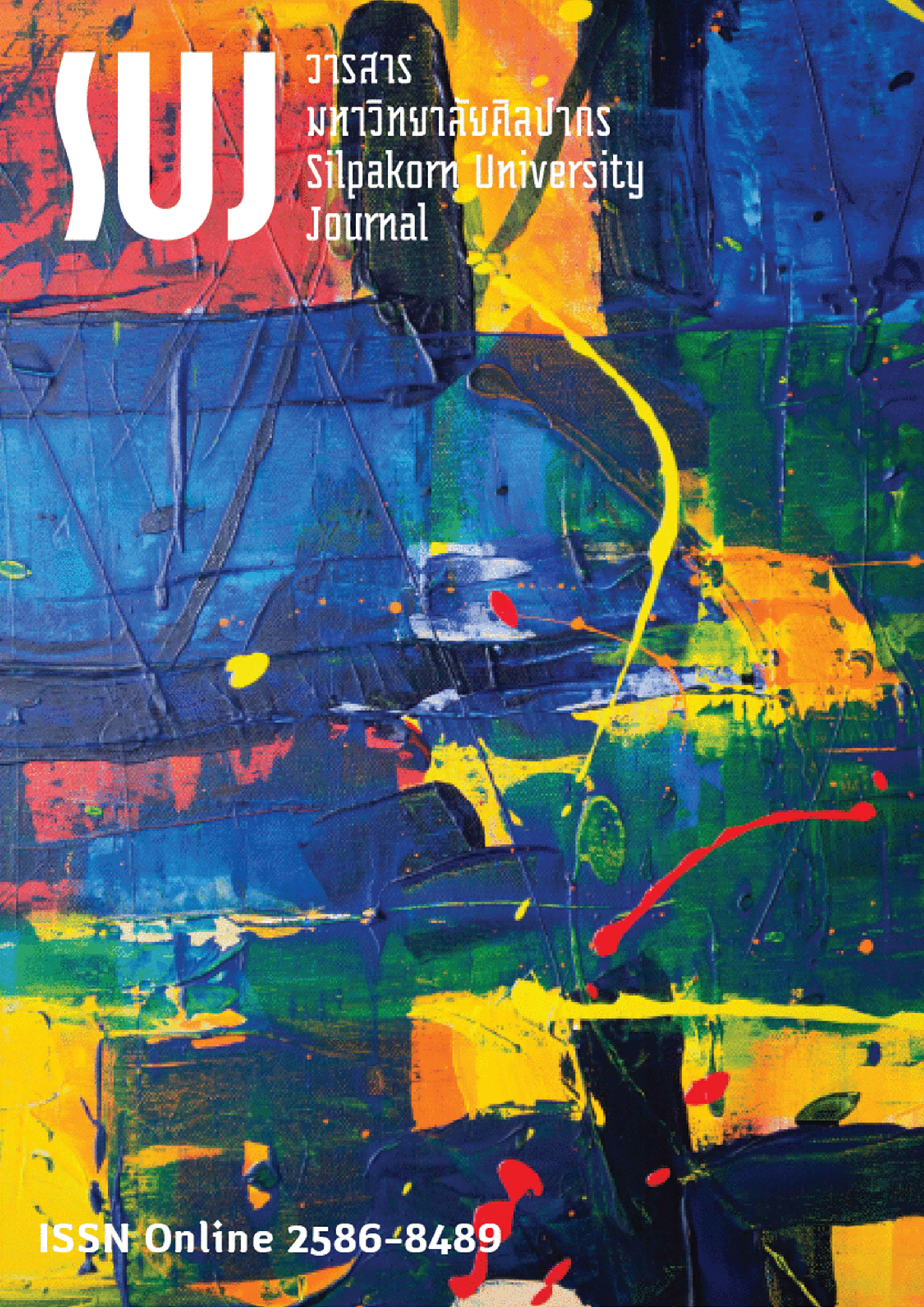องค์ประกอบตัวชี้วัดแหล่งท่องเที่ยวที่ส่งผลต่อการเป็นแหล่งเรียนรู้เชิงธรณีวิทยา จังหวัดเชียงราย (Indicator elements of tourist sites that affect the determination of geology learning areas in Chiang Rai province)
Main Article Content
Abstract
การวิจัยครั้งนี้มีเป้าหมาย คือ การค้นหาตัวชี้วัดที่นำไปสู่การกำหนดพื้นที่แหล่งเรียนรู้เชิงธรณีวิทยาในพื้นที่แหล่งท่องเที่ยวรอยเลื่อนมีพลังของจังหวัดเชียงราย ที่มีคุณค่าต่อประสบการณ์ในการเรียนรู้และเอื้อต่อการเป็นจุดหมายปลายทางการท่องเที่ยวทางธรณีวิทยา มีวัตถุประสงค์เพื่อวิเคราะห์องค์ประกอบตัวชี้วัดแหล่งท่องเที่ยวที่ส่งผลต่อการเป็นแหล่งเรียนรู้เชิงธรณีวิทยาผ่านแหล่งท่องเที่ยวรอยเลื่อนมีพลังในพื้นที่จังหวัดเชียงราย กลุ่มตัวอย่างการวิจัย ได้แก่ ประชาชน นักท่องเที่ยว ผู้นำชุมชน และผู้ประกอบการ จำนวน 400 คน ซึ่งได้มาด้วยวิธีการสุ่มแบบแบ่งชั้นภูมิ เครื่องมือที่ใช้เก็บรวบรวมข้อมูลเป็นแบบสอบถามแบบมาตราส่วนประมาณค่า 5 ระดับ ทำการวิเคราะห์ข้อมูลโดยใช้ค่าร้อยละ และการวิเคราะห์องค์ประกอบเชิงยืนยัน ผลการวิจัยพบว่า ตัวชี้วัดแหล่งท่องเที่ยวที่ส่งผลต่อการเป็นแหล่งเรียนรู้เชิงธรณีวิทยาผ่านแหล่งท่องเที่ยวรอยเลื่อนมีพลังในพื้นที่จังหวัดเชียงราย ประกอบด้วย 5 องค์ประกอบ จำนวน 22 ตัวชี้วัด โดยองค์ประกอบที่ 1 ด้านภาพลักษณ์แหล่งท่องเที่ยว 4 ตัวชี้วัด องค์ประกอบที่ 2 ด้านการให้บริการ 6 ตัวชี้วัด องค์ประกอบที่ 3 ด้านการบริหารจัดการแหล่งท่องเที่ยว 5 ตัวชี้วัด องค์ประกอบที่ 4 ด้านการมีส่วนร่วมของผู้เกี่ยวข้อง 3 ตัวชี้วัด และองค์ประกอบที่ 5 ด้านการออกแบบกิจกรรมการท่องเที่ยว 4 ตัวชี้วัด และพบว่าองค์ประกอบย่อยของตัวชี้วัดด้านการให้บริการ มีค่าน้ำหนักมากที่สุด โดยผู้ที่มีส่วนเกี่ยวข้องสามารถนำองค์ประกอบและตัวชี้วัดที่ได้ไปเป็นแนวทางในการสร้างเป็นแหล่งเรียนรู้เชิงธรณีวิทยาผ่านแหล่งท่องเที่ยวรอยเลื่อนมีพลังในพื้นที่จังหวัดเชียงราย รวมถึงส่งเสริมให้มีการจัดทำศูนย์การเรียนรู้หรือแหล่งเรียนรู้ให้เกิดขึ้นภายในพื้นที่แหล่งท่องเที่ยว ทั้งนี้ เพื่อให้นักท่องเที่ยวสามารถแสวงหาความรู้ การรักษาคุณค่าและเกิดจิตสำนึกจากการเรียนรู้ด้วยตนเอง
This study aimed to investigate the determinants leading to the determination of geology learning sites in active fault tourist areas in Chiang Rai Province that is valuable for learning experiences and conducive to a geological tourism destination. The study analyzed the indicator elements of tourism sites that affected being a geology learning site along active fault tourist areas in Chiang Rai Province. The sample of 400 people included residents, tourists, community leaders, and entrepreneurs drawn by stratified random sampling. The data collection tool was a five-point Likert scale questionnaire. The percentage and confirmatory factor analysis were applied for the data analysis. The results showed that 22 indicators from five elements affected the determination of a geology learning site along active fault tourist areas in Chiang Rai Province. The first element in tourist site image comprised four indicators; the second element in service provision had six indicators; the third element in tourist site management consisted of five indicators; the fourth element in stakeholder participation comprised three indicators; and the fifth element in the design of tourist activities had four indicators. The results also revealed that the sub-element in service provision had the highest value of variables. Those involved can apply the indicator elements obtained as guidelines for creating a geology learning site along the active fault tourist areas in Chiang Rai province. Moreover, they can promote the establishment of learning centers or resources within the tourist areas so that tourists can seek knowledge, reserve values, and develop consciousness through self-learning.
Downloads
Article Details

This work is licensed under a Creative Commons Attribution-NonCommercial-NoDerivatives 4.0 International License.
References
Angsuchoti, Supamas, Wijitwanna, Somtawin, & Pinyopanuwat, Ratchaneekool. (2014). Analytical Statistics for Social and Behavioral Science Research: Techniques for using the LISREL Program (สถิติวิเคราะห์สำหรับการวิจัยทางสังคมศาสตร์และพฤติกรรมศาสตร์: เทคนิคการใช้โปรแกรม LISREL) (4th ed.). Bangkok: CDMK printing.
Boodsri, Komprat. (2008). Administration Model of Tourist Information Center: A Case Study of Tourist Information Center, Nakohnpathom Province (การศึกษาหาแนวทางรูปแบบการบริหารจัดการศูนย์บริการนักท่องเที่ยว : กรณีศึกษาศูนย์บริการนักท่องเที่ยวแสดง และจำหน่ายผลิตภัณฑ์ชุมชนและท้องถิ่นจังหวัดนครปฐม). Master’s dissertation, Chulalongkorn University, Bangkok, Thailand.
Bunnag, Orawee. (2015). The strategies of releasing tourism public relation messages on Valentine’s day love festival of tourism authority of Thailand (กลยุทธ์การนําเสนอสารประชาสัมพันธ์การท่องเที่ยวในวันแห่งความรักของการท่องเที่ยวแห่งประเทศไทย). Journal of Thai Hospitality & Tourism, 10(2): 34-46.
Division of Environmental Geology, Department of Mineral Resources. (2009). A Project to Study the Recurrence Period in the Area Showing Active Fault Traces in Chiang Rai, Chiang Mai and Phayao Provinces (โครงการศึกษาคาบอุบัติซ้ำในพื้นที่ที่แสดงร่องรอยการเลื่อนตัวของรอยเลื่อนมีพลังในจังหวัดเชียงราย เชียงใหม่ และพะเยา (กลุ่มรอยเลื่อนแม่จัน และ กลุ่มรอยเลื่อนพะเยา)). Bangkok: Department of Mineral Resources, Ministry of Natural Resources and Environment.
Jantakham, Supamitr, Sairaksa, Danwichai, & Singhalert, Rungsan. (2020). The geotourism development strategies for Khon Kean geopark towards to UNESCO global geopark (ยุทธศาสตร์การพัฒนาการท่องเที่ยวเชิงธรณีของอุทยานธรณีขอนแก่นสู่อุทยานธรณีโลกของยูเนสโก). Journal of Education Rajabhat Maha Sarakham University, 17(1): 599-611.
Kamcha, Chatchana. (2012). Guidelines for Presenting Geological Conservation Sites/Geological Parks to be Attractive and Attractive to Tourists (แนวทางการนำเสนอแหล่งอนุรักษ์ธรณีวิทยา/อุทยานธรณีให้มีความน่าสนใจและดึงดูดนักท่องเที่ยว). Bangkok: Geology Bureau, Department of Mineral Resources.
Kanchanawasri, Sirichai. (2007). Theory of Assessment (ทฤษฎีการประเมิน) (5th ed.). Bangkok: Chulalongkorn University Press.
Kline, R. B. (2005). Principles and Practice of Structural Equation Modeling (2nd ed.). New York: The Guilford Press.
Osborne, J. W., & Costello, A. B. (2004). Sample size and subject to item ratio in principal components analysis. Practical Assessment, Research, and Evaluation, 9: 11.
Seismological Bureau, Meteorological Department. (2016). Earthquake Report in Thailand and Adjacent Areas in May 2016 (รายงานการเกิดแผ่นดินไหวบริเวณประเทศไทยและพื้นที่ใกล้เคียงเดือนพฤษภาคม พ.ศ. 2559). [Online]. Retrieved March 24, 2021 from https://earthquake.tmd.go.th/report/file/seismo-report-1468386467.pdf
Singchungchai, Phechnoy. (2006). Principles and Using Multivariate Statistics Analysis for Nursing Research (หลักการและการใช้สถิติการวิเคราะห์ตัวแปรหลายตัว สำหรับการวิจัยทางการพยาบาล) (3rd ed.). Songkhla: Chanmuang Press.
UNESCO. (2015). Global Geoparks (อุทยานธรณี). [Online]. Retrieved March 15, 2021 from https://hmong.in.th/wiki/Geopark


